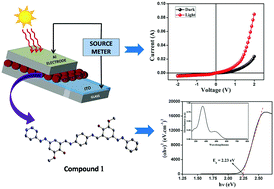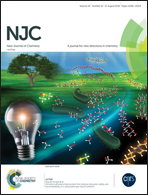Experimental and computational investigations of the photosensitive Schottky barrier diode property of an azobenzene based small organic molecule†
Abstract
Azo based organic semiconductor molecules are mostly used as write once, read-many-times (WORM) memory systems. Therefore, a large scope still remains in the fabrication of photoconducting azo compounds, which can be used under acute conditions for advanced applications. In this context we have designed a very simple, small azo based organic molecule, viz. [1,4-phenylenebis(azanylylidene)bis(methanylylidene)bis(2-methoxy-4-(phenyldiazenyl)phenol)] (compound 1). The device fabricated using compound 1 showed Schottky barrier behavior. The value of the rectification ratio is 6.22 and 18.27 under dark and photoirradiated conditions, respectively. Thermally stable and low cost compound 1 can be used in the area of optoelectronic devices probably being the first azo-organic material showing such properties. Experimentally measured optical conductivity is again correlated theoretically using DFT computation. It has been observed that the change in the dihedral angle produces a decrease in the energy for the allowed electronic transition.



 Please wait while we load your content...
Please wait while we load your content...